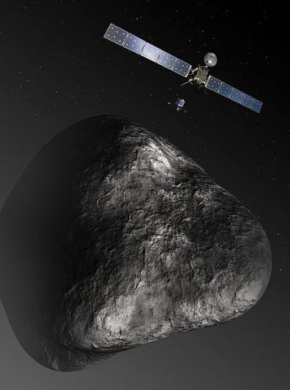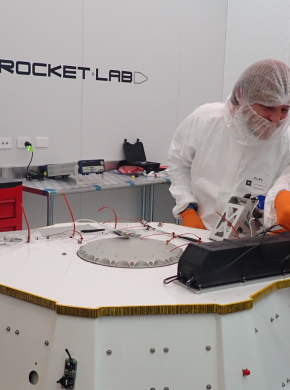The ARTES Competitiveness & Growth programme element (ARTES C&G) is dedicated to the development, verification and demonstration of products for the satellite telecommunications market.
Products might be any hardware, software, system or sub-system or services.
Contracts are awarded on the basis of proposals made by industry for the development of products for future commercial exploitation.
The ARTES Competitiveness & Growth programme element supports four Development Phases:

- The Definition Phase supports industry in the initial definition and top-level design of the product, along with any systems engineering that may be required to define it and to identify the optimal solution for the target market.
- The Technology Phase supports industry in mitigating key technical risks. This phase excludes qualification for space equipment and industrialisation of ground equipment.
- The Product Phase supports the development and verification of the product to make it ready for commercialisation in its intended operational environment.
- The Demonstration Phase supports market entry for space products (Atlas) and the validation of ground segment products in the operational environment.
The maximum funding limits for each phase are aligned with the risk associated with those phases and specially supports Small and Medium Enterprises (SMEs).

FINANCIAL SUPPORT – CO-FUNDING LEVELS AND INDUSTRIAL-ACADEMIC COLLABORATION
It’s important to note that specific funding levels apply when universities and research institutes without commercial interest are involved in a project. This allows industry to work closely with these partners in developing new products, fostering innovation and industrial-academic collaboration.
An overview of the maximum funding levels for each Development Phase is provided below: 
Please note that the funding level for an activity is subject to the discretion of ESA and the National Delegation concerned, up to the maximum level identified in the table above.
ADVANTAGES OF MULTIPLE PHASES
The ARTES C&G industry-driven programme with its four Development Phases encompasses the complete product development cycle: from the initial idea through to the final product. Moving from one phase to the next is simplified and the concept allows work in parallel (phases can overlap) to streamline the product development. A contract can be simply extended via a Contract Change Notice (CCN) in line with the needs of the targeted product development.
“The arrangement follows closely the typical product development cycle of Satcom industry, allows the allocation of funding in line with the risks and offers National Delegations flexibility when allocating funding,”
Domenico Mignolo, Acting Head of the Technologies and Products Division, Connectivity and Secure Communications Directorate, ESA
The business plan for proposals shall be commensurate with the development status. An activity with a low starting TRL proposed in the Technology Phase therefore does not need to include the type of detailed business plan that is required for later development phases.
Take the initiative!
To apply for ARTES C&G, industry has to set the wheels in motion. The first step is to prepare an Outline Proposal and Financial Forecast Workbook, using the templates provided, and submit these to ARTES C&G CFP.
ESA will provide feedback within 10 working days.
Proposals are confidential and negotiated directly. The corresponding ARTES C&G ‘Call for Proposals’ (CfP) is always open. The latest issue is available online on esa-star (Call for Proposals 4-40017). To download the documents, registration on esa-star is required.
If you have any questions please don't hesitate to contact us at ARTES-C&G@esa.int.
ELIGIBILITY REQUIREMENTS
To submit an ARTES Competitiveness & Growth proposal, you must meet the following eligibility requirements:
- A significant part of the business case should address the satcom. Proposed developments can be an end-to-end satcom system, or the improvement or development of a satcom Ground Segment product such as a user terminal or gateway equipment. For the Space Segment, you may wish to improve or develop a satellite platform, a software, an advanced test system, an attitude and orbit control sub-system, a payload, an amplifier or any other satellite equipment. The development and operation of a small satellite (up to 5 Mio ESA price in Atlas) demonstrating the required functions in orbit is also supported.
- ESA will only admit proposals for evaluation that come from companies or organisations – whether as Prime or Subcontractor – residing in one of the following countries:
Austria, Belgium, Canada, Czech Republic, Denmark, Finland, France, Germany, Greece, Hungary, Ireland, Italy, Luxembourg, The Netherlands, Norway, Poland, Portugal, Romania, Spain, Sweden, Switzerland, United Kingdom
- It is mandatory that companies (both Prime Contractor and Subcontractor(s)) obtain formal authorisation from their National Delegation to carry out the proposed activity.
Related links
NEWS AND EVENTS
ESA celebrates completion of neXat’s award-winning virtual platform for satellite connectivity
A Belgian company specialising in cloud-based solutions for the telecommunications industry - neXat - has recently presented its newly developed product, neXat Satellite Services Aggregation Platform (neXat SAP) for the management of satellite…
ESA-supported advanced photonics manufacturing project for next-generation satelli…
The European Space Agency (ESA) continues to drive forward-looking satellite technologies through its Advanced Manufacturing Processes for High Reliability Photonics Transceivers (AutoMAIT) project. The successful activity has demonstrated an…
ESA Supports Austrian Innovation in Multi-Orbit Satellite Communications Technology
The European Space Agency (ESA), together with the Austrian Aerospace Agency (ALR/FFG) and the Federal Ministry of Innovation, Mobility and Infrastructure, is supporting the Multibeam Ka-band Satellite User Terminal (MUKAS) project, funded…
ESA-supported Space INSPIRE product line makes next step to launch
The first Space INSPIRE (INstant SPace In-orbit REconfiguration) propulsion system module, recently completed at Thales Alenia Space's Belfast facility, has now arrived in Cannes for integration into the ASTRA 1Q satellite, the first of the Space…
ESA and RBC Signals UK kick off STORM project for dynamic satellite spectrum management
The European Space Agency (ESA) and RBC Signals UK have signed a contract to develop the Spectrum Trade Orchestration and Resource Management (STORM) platform, an innovative solution designed to transform static…
How ESA supported the demonstration of spatially combined amplifiers across Ka and Q Bands
The European Space Agency (ESA) remains a key supporter of advanced satellite technologies, as shown through the "Spatial Power Combining Amplifiers at Ka and Q/V Bands for Telecom Satellites" project. The successful…
How to extend the lifespan of satellites and enabling cost efficiency through AI software
AI investment is booming globally, ESA is helping drive the ongoing transformation, enabled by technological innovations in the satellite telecommunication operations, through strategic research and development…
European Space Agency’s ARTES programme introduces agile process to meet growi…
The European Space Agency’s (ESA) Advanced Research in Telecommunications Systems (ARTES) programme, through the Directorate of Connectivity and Secure Communications, is streamlining its programmatic tools to…
ARTES support leads to MDA Advanced Radiating Antenna (DRA) contract for Telesat Lightspeed
Canadian space technology company MDA has been selected to provide one of the critical technology subsystems on the Telesat Lightspeed satellites. Telesat Lightspeed is the new leading edge low Earth orbit (LEO) satellite broadband network…
GRASP: seizing the benefits of a single antenna design tool
Reflector antennas are by far the most used technology for telecom satellite and ground station antennas. TICRA, a leading provider of cutting-edge reflector antenna modelling software based in Copenhagen, has now under the ARTES programme made…
AlbaPod: the most advanced space-proven PocketQube deployer
The ‘maker’ movement in electronics and the meteoric rise of smartphones have led to a surge in small satellites - such as nano- and picosatellites (picosats are the tiniest of smallsats). But something has to propel these pocket-size payloads…
Novel flat panel antennas give drones long-range satcom capabilities
A satellite communications antenna which fits snugly into the wing of a UAV or ‘Remotely Piloted Aircraft’ (RPA) for use in long-range missions has now ‘got its wings’ – giving the green light for a variety of civilian applications across…














